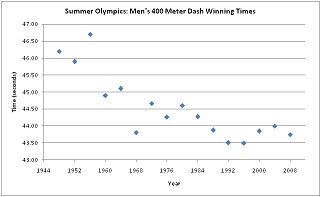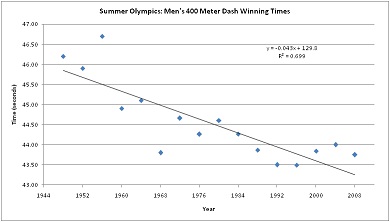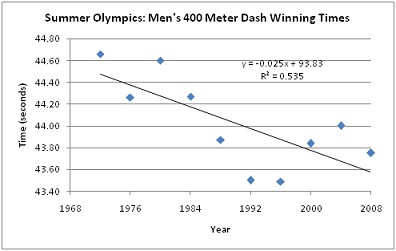Reference no: EM131113791
Curve-Fitting Project - Linear Model: Men's 400 Meter Dash
(LR-1) Purpose: To analyze the winning times for the Olympic Men's 400 Meter Dash using a linear model
Data: The winning times were retrieved from https://www.databaseolympics.com/sport/sportevent.htm?sp=ATH&enum=130
The winning times were gathered for the most recent 16 Summer Olympics, post-WWII. (More data was available, back to 1896.)
DATA:
|
Summer Olympics:
Men's 400 Meter Dash
Winning Times
|
|
Year
|
Time (seconds)
|
|
1948
|
46.20
|
|
1952
|
45.90
|
|
1956
|
46.70
|
|
1960
|
44.90
|
|
1964
|
45.10
|
|
1968
|
43.80
|
|
1972
|
44.66
|
|
1976
|
44.26
|
|
1980
|
44.60
|
|
1984
|
44.27
|
|
1988
|
43.87
|
|
1992
|
43.50
|
|
1996
|
43.49
|
|
2000
|
43.84
|
|
2004
|
44.00
|
|
2008
|
43.75
|
(LR-2)SCATTERPLOT:

As one would expect, the winning times generally show a downward trend, as stronger competitionand training methods result in faster speeds.The trend is somewhat linear.
(LR-3)

Line of Best Fit (Regression Line)
y = -0.0431x + 129.84 where x = Year and y = Winning Time (in seconds)
(LR-4) The slope is -0.0431 and is negative since the winning times are generally decreasing.
The slope indicates that in general, the winning time decreases by 0.0431 second a year, and so the winning time decreases at an average rate of 4(0.0431) = 0.1724 second each 4-year Olympic interval.
(LR-5) Values of r2 and r:
r2 = 0.6991
We know that the slope of the regression line is negative so the correlation coefficient r must be negative.
r=-√0.6991=-0.84
Recall that r = -1 corresponds to perfect negative correlation, and so r =-0.84 indicates moderately strong negative correlation (relatively close to -1 but not very strong).
(LR-6) Prediction: For the 2012 Summer Olympics, substitute x = 2012 to gety = -0.0431(2012) + 129.84 ≈ 43.1 seconds.
The regression line predicts a winning time of 43.1 seconds for the Men's 400 Meter Dash in the 2012 Summer Olympics in London.
(LR-7) Narrative:
The data consisted of the winning times for the men's 400m event in the Summer Olympics, for 1948 through 2008. The data exhibit a moderately strong downward linear trend, looking overall at the 60 year period.
The regression line predicts a winning time of 43.1 seconds for the 2012 Summer Olympics, which would be nearly 0.4 second less than the existing Olympic recordof 43.49 seconds, quite a feat!
Will the regression line's prediction be accurate? In the last two decades, there appears to be more of a cyclical (up and down) trend. Could winning times continue to drop at the same average rate? Extensive searches for talented potential athletes and improved full-time training methods can lead to decreased winning times, but ultimately, there will be a physical limit for humans.
Note that there were some unusual data points of 46.7 seconds in 1956 and 43.80 in 1968, which are far above and far below the regression line.
If we restrict ourselves to looking just at the most recent winning times, beyond 1968, for Olympic winning times in 1972 and beyond (10 winning times), we have the following scatterplot and regression line.

Using the most recent ten winning times, our regression line is y =-0.025x + 93.834.
When x = 2012, the prediction is y = -0.025(2012) + 93.834 ≈ 43.5 seconds. This line predicts a winning time of 43.5 seconds for 2012 and that would indicate an excellent time close to the existing record of 43.49 seconds, but not dramatically below it.
Note too that for r2 = 0.5351and for the negatively sloping line, the correlation coefficient isr=-√0.5351=-0.73, not as strong as when we considered the time period going back to 1948.The most recent set of 10 winning times do not visually exhibit as strong a linear trend as the set of 16 winning times dating back to 1948.
CONCLUSION:
I have examined two linear models, using different subsets of the Olympic winning times for the men's 400 meter dash and both have moderately strong negative correlation coefficients. One model uses data extending back to 1948 and predicts a winning time of 43.1 seconds for the 2012 Olympics, and the other model uses data from the most recent 10 Olympic games and predicts 43.5 seconds. My guess is that 43.5 will be closer to the actual winning time. We will see what happens later this summer!
UPDATE: When the race was run in August, 2012, the winning time was 43.94 seconds.
|
Probability of p being defective
: A manufacturer produces items that have a probability of p being defective. These items are formed into batches of 150. Past experience indicates that some batches are of good quality
|
|
Social pressures have in influencing organizational ethics
: Restaurant manager What role do external social pressures have in influencing organizational ethics? How might these issues be relevant to organizational decisions? What is the relationship between legal and ethical issues? Format your paper consiste..
|
|
How positive psychology manifests itself in your workplace
: In your own words, define positive psychology. Explain how positive psychology manifests itself in your workplace. Assess whether positive psychology is more applicable to performance appraisal processes or the training and development process.
|
|
Compute the ending inventory for midori company
: Midori Company had ending inventory at end-of-year prices of $100,000 at December 31, 2009; $119,900 at December 31, 2010; and $134,560 at December 31, 2011.
|
|
Analyze the winning times for the olympic mens dash
: To analyze the winning times for the Olympic Men's 400 Meter Dash using a linear model. The winning times were gathered for the most recent 16 Summer Olympics, post-WWII. (More data was available, back to 1896.)
|
|
What the classifications of probation and parole caseloads
: What are the administrative responsibilities of probation and parole caseloads? What are the classifications of probation and parole caseloads
|
|
Using sales dollars as the measure of output
: A retail store had sales of $33,500 in April and $68,500 in May. The store employs nine fulltime workers who work a 40 - hour week. In April the store also had six part-time workers at 10 hours per week, and in May the store had eleven part-timers at..
|
|
Measure for length in the publishing business
: A gry is an old English measure for length, defined as a1/10 of a line, where line is another old English measure for length, defined as 1/2 inch. A common measure for length in the publishing business is a point, defined as 1/72 inch.
|
|
Development and operations of policing organizations
: How do past, current, and future trends impact the development and operations of policing organizations? What recommendations would you make to improve the overall development and operations of the policing field
|